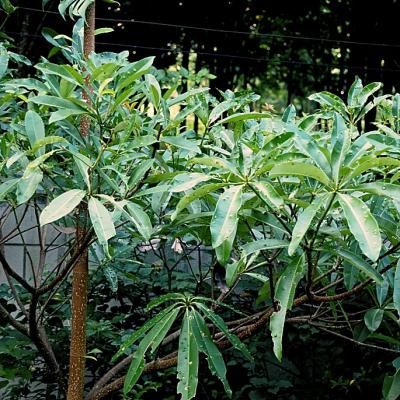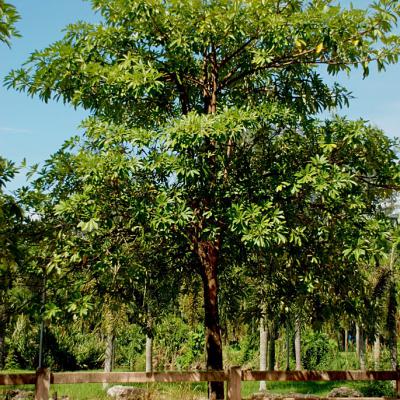Apocynaceae-Alstonia-scholaris
Classification
- Botanical Family : Apocynaceae
- Genus : Alstonia
- Epithet : scholaris
- German Family Name: Hundsgiftgewächse
- English Name: Devil Tree, Dita Bark Devil Tree, Dita Bark Devil Tree, Dita Bark
- Thai Name: พญาสัตบรรณ ตีนเป็ด
- Thai Phonetic: teen ped
- Author: (L.) R.Br.
Water Requirements
Plant Type
Light Requirements
Cultivation
Alstonia scholaris is a large, very ornamental tree, which is frequently found in the vegetation on roadsides. It can reach 12 to 20 m. Its branches grow in tiers and are about evenly around the trunk arranged so that the crown looks like an umbrella.
The tree needs plenty of space for its sweeping crown in the garden. He is a good shade, which is frequently visited by birds, bees and butterflies.The greenish-yellow flowers are inconspicuous and small, but very persistent and very fragrant. The flowering period extends mainly between June and November.
The fruit hanging in pairs and are slightly curved or wavy, thin pods that are 20 to 45 cm long. In the bark flows a sticky, bitter latex.
The slightly rounded, leathery, dark green leaves form whorls of 4-7 leaves.
Young trees are susceptible to termites.
The tree needs regular watering. Is it too big, he can tolerate a radical cut. He drives off.
All parts of the tree are poisonous.
Propagation: by seeds or by cuttings. Young branches can be removed from the tree and after a few days of treatment with root starter enzyme it can be placed directly into the ground.
Alstonia scholaris ist ein großer, sehr dekorativer Baum, der häufig in der Bepflanzung an Straßenrändern zu finden ist. Er kann 12 bis 20 m erreichen. Seine Äste wachsen etagenförmig und sind gleichmäßige rund um den Stamm herum angeordnet, so daß die Krone wie ein Schirm aussieht.
Der Baum braucht wegen seiner ausladenden Krone viel Platz im Garten. Er ist ein guter Schattenspender, der gern von Vögeln, Bienen und Schmetterlingen besucht wird.
Die grünlich-gelben Blüten sind unscheinbar und klein, duften aber sehr nachhaltig und stark. Die Blütezeit erstreckt sich hauptsächlich zwischen Juni und November.
Die Früchte hängen in Paaren und bilden leicht gewellte oder gebogene, dünne Schoten, die 20 bis 45 cm lang werden. In der Rinde fließt ein klebriger, bitterer Milchsaft.
Die leicht abgerundeten, ledrigen, dunkelgrünen Blätter bilden Wirtel von 4-7 Blätter.
Junge Bäume sind anfällig für Termiten.
Der Baum braucht regelmäßig Wasser. Ist er zu groß geraten, verträgt er auch einen Radikalschnitt. Er treibt wieder aus.
Alle Teile des Baumes sind giftig.
Vermehrung: durch Samen oder durch Stecklinge. Junge Äste können vom Baum abgetrennt werden und nach einigen Tagen Behandlung mit Bewurzelungsenzym kann er direkt in die Erde gesetzt werden.
Origin
Miscelaneous
Alstonia is named after Dr. C. Alston (1685-1760), professor of botany at the University of Edinburgh.
The wood of the tree is not stable enough to make something of it. In Sri Lanka, however, be made from the wood coffins and also for the production of parchment, the tree has been used previously in South Asia. In addition, in Myanmar made from the wooden writing tablets for school children, hence the name "scholaris". The tree is commonly known as the Devil's tree, as it is to be the abode of the devil, the mythology says.
In Sri Lanka Alstonia scholaris is cultivated for fuelwood in plantations.
Ethnomedical uses
The ethnomedical information is provided for general information only, it is not intended as guidance for medicinal use.
Alstonia scholaris is in homeopathy, as well as in phytotherapy and aryuvedic medicine as an antipyretic agent (1), used for malaria, dysentery and abdominal pain. (2) The milky juice is applied externally to treat ulcers, wounds, tumors, rheumatic discomfort, itching and ear pain. (3)
Alstonia wird nach Dr. C. Alston (1685-1760), Professor für Botanik an der Universität Edinburgh benannt.
Das Holz des Baumes ist zu wenig stabil, um etwas daraus zu machen. Auf Sri Lanka werden aus dem Holz allerdings Särge hergestellt und auch zur Herstellung von Pergament wurde der Baum früher in Südasien verwendet. Zudem wurden in Myanmar aus dem Holz Schreibtafeln für Schulkinder hergestellt, daher auch der Name „scholaris“. Der Baum wird gemeinhin als der Teufelsbaum bezeichnet, da er der Aufenthaltsort des Teufels sein soll, so die Mythologie.
In Sri Lanka wird Alstonia scholaris auch für Brennholz in Plantagen angebaut.
Volksmedizinische Verwendung
Die Berichte über volksmedizinische Verwendung ist nur zur allgemeinen Information und nicht als medizinischer Ratgeber zu betrachten.
Verwendet werden Blätter, Rinde und der Milchsaft der Rinde.
Alstonia scholaris wird in der Homöopathie, als auch in der Phytotherapie und der aryuvedischen Medizin als fiebersenkendes Mittel (1), bei Malaria, Bauchschmerzen und Ruhr (2) verwendet. Der Milchsaft wird äußerlich zur Behandlung von Geschwüren, Wunden, Tumoren, rheumatischer Beschwerden, Juckreiz und Ohrenschmerzen aufgetragen. (3)
(1) http://homoeopathischer-notdienst.de/Arzneimittelbild/Alstonia-Scholaris
(2) http://www.herbsnspicesinfo.com/medicinal-herbs/alstonia-scholaris.aspx
(3) http://www.pflanzenguru.com/pflanzen-der-ayurveda/107-saptaparna-ditabaum-alstonia-scholaris.html


